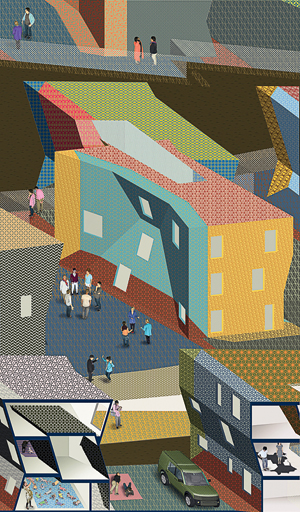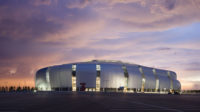In placing an emphasis on socially and environmentally conscious subjects, two New York museums must address the challenges of presentation.
Architectural exhibitions aimed at a general audience are hard to pull off. Small-scale representations'photographs, models, drawings, and, increasingly, video'can only approximate the sense of the full-size work. Like art objects, they need to captivate the museum visitor while acknowledging the thicket of constraints'program, site, budget'that shape the form. If the projects have a socially or environmentally conscious dimension, the challenge is tougher: The display may lack the wow factor'the visual panache of extravagantly innovative or elegant architectural works and objects that make museum visitors stop in their tracks. And the danger lurks that providing the necessary information to appreciate the projects displayed will make the show look like a walk-in book.

MoMA's Foreclosed: Rehousing the American Dream includes Zago Architecture's animation for its colorful proposal for Rialto, California. Read our review of the exhibition: "Foreclosed" Reopens the American Dream
Undaunted by such issues, two leading art and design institutions, the Museum of Modern Art (MoMA) and the Smithsonian Cooper-Hewitt, National Design Museum, both in New York, have been embracing this type of exhibition in the last few years. Both museums have boldly organized design shows that address issues of problematic living conditions around the globe.
When Cooper-Hewitt mounted Design for the Other 90%, at its palatial quarters on upper Fifth Avenue in 2007, it generated a lot of media attention and an audience of 100,000. In 2009, the museum designated Cynthia Smith, who had organized that show, as the Curator of Socially Responsible Design. Smith, an industrial designer with a background in public service, followed up with a sequel, Design with the Other 90%: CITIES, which opened for a three-month run in October 2011 at the United Nations while Cooper-Hewitt is expanding its building. The show displayed 65 projects from 25 countries, concentrating on slums and informal settlements in the Global South; it drew 150,000 visitors, including many UN diplomats and staff. 'The United Nations was a great location,' says Smith.
MoMA's exhibitions in this arena have been even more popular with the public. Rising Currents: Projects for New York's Waterfront, devoted to architects' theoretical solutions to rising sea levels from global warming, hit a high of 881,520 visitors over its six-and-a-half-month duration in 2010. Small Scale, Big Change: New Architectures of Social Engagement, which examined innovative design created for underserved communities on five continents, opened in October 2010, and drew 311,188 during its three-month stay.
And now MoMA has just installed Foreclosed: Rehousing the American Dream, on view until July 30. With this exhibition, the museum has further deepened its socially conscious identity under the aegis of Barry Bergdoll, the chief curator of architecture and design since 2006. Bergdoll, also a Columbia University professor of architectural history, seems an unlikely candidate to lead MoMA away from monographic exhibitions on Frank Lloyd Wright or Mies van der Rohe, with which the museum has become so identified. Yet Bergdoll points out that MoMA's first architecture show, the legendary Modern Architecture: International Exhibition of 1932, had a social housing component. Over the decades similar subjects appeared sporadically there.
But the frequency of do-good shows clearly has stepped up. As Joseph Rosa, the director of the University of Michigan Museum of Art notes, 'The museum today is becoming more of an incubator of ideas, with people thinking about socially minded critiques of culture.' Bergdoll says he is trying to pose questions not addressed in normal architectural commissions. 'But the shows do involve architects whose work is already of interest, so we are continuing the traditional role of MoMA in culling the finest talent.'
Like the Rising Currents show, the Foreclosed exhibition put MoMA in an activist role, actually commissioning speculative solutions, developed through a workshop process. Bergdoll, who organized the project with Reinhold Martin, Director of Columbia University's Temple Hoyne Buell Center for the Study of American Architecture, isolated five geographical areas in the U.S., from Florida to California, where the banking mortgage crisis of 2007'08 led to stalled projects and swaths of publicly held land now available for development. For each of the five sites'identified based on Buell Center research'Bergdoll and Martin assigned a team, led by architects and including experts in finance, housing, planning, and infrastructure. Each team created proposals meant to provoke new ways of thinking about housing and dense community living: Bergdoll wants to engage the public in understanding 'how architects think.'
For example, among the Foreclosed teams'which include Studio Gang, MOS, WORKac, and Visible Weather'Zago Architecture has proposed redesigning a failed subdivison, pocked with unbuilt lots, in an unincorporated section of Rialto, east of Los Angeles. Principal Andrew Zago's quixotic and colorful scheme presents various housing types, such as duplexes and row houses, rearranged to avoid the deadly repetitiveness of the subdivision house/yard/driveway model.
As is typical in socially oriented exhibitions, Foreclosed includes a good deal of nonvisual material: One gallery is devoted solely to presenting data underpinning the show's program. Granger Moorhead, who designed the Cooper-Hewitt exhibition at the UN, tackled the problem of grainy photos and variously fabricated architectural models by abandoning any notion of a slick, 'museum-quality' look. Instead, 'We tried to present the content in an informal, collaged way,' he says.
With such thorny matters to consider, museums wisely seek a balance of subjects. In the near future the Cooper-Hewitt will devote an exhibition to graphic design, while MoMA plans two architecture shows next'one on proto-Modernist Henri Labrouste; the other, its first retrospective of Le Corbusier. Ars longa....





Post a comment to this article
Report Abusive Comment